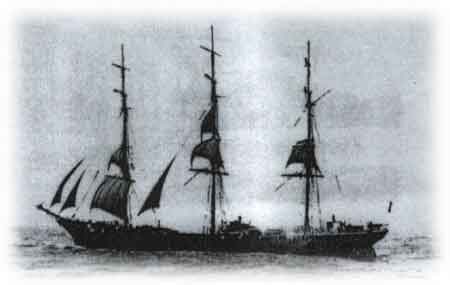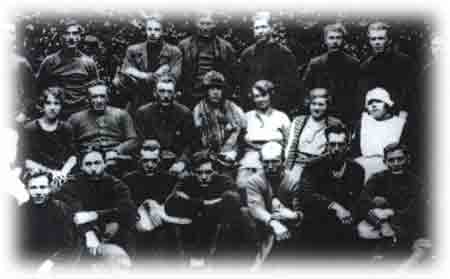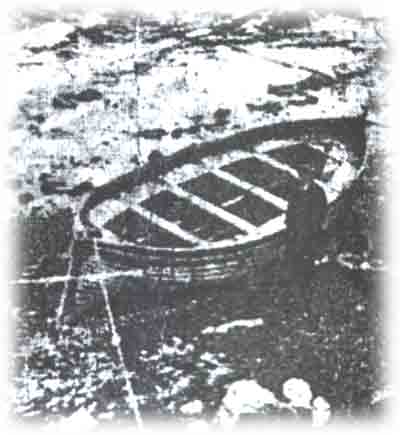Epic
Landfall for Shipwrecked Sailors at Gyrn Goch
~ 1927
An
explosion and fire on board the Fortuna, a South
Atlantic-bound whaling supply ship, off the southern
coast of Ireland on Friday, 28th October, 1927, had
unexpected repercussions for Gyrn Goch and the nearby
village of Clynnog.
An
ageing, three masted, iron hulled sailing vessel,
manned by a Norwegian crew of 26 under the command
of Captain Olav Larsen, the Fortuna belonged to the
Argentina Whaling Company, the Compania Argentina
de Pesca (PESCA). This was an Argentine financed
Norwegian venture based in the British dependency
of South Georgia, 800 kms south-east of the Falklands.
Established in 1904, following a prohibition on whaling
in Norwegian waters, and functioning until 1965,
the enterprise initially proved wonderfully profitable
and provided seasonal employment for 300 workers
at its whaling station at Grytviken.
Image: The
Fortuna.
Since
her purchase by PESCA in 1916, the 1793 ton Fortuna
had regularly plied between Grytviken and England,
with an average each way journey time of under 70
days. Inbound, she carried whale oil and guano, and
on her return voyage coal, food and empty oil barrels.
On
her final, diasterous, journey, having discharged
11,400 barrels of whale oil at Liverpool, and taken
on 3000 tons of coal and 1000 empty oil containers,
the Fortuna set sail from the Mersey on Sunday, October
23rd. Five days later, some 10 miles south of the
Irish coast, in extremely rough weather, a violent
explosion blew up the main cabin and the seamen's
mess-room and set the ship aflame. The fire spread
quickly and could not be extinguished. The cause
of the fire was probably the accidental ignition
of calcium carbide, a highly flammable chemical that
was used to produce acetylene gas for lighting.
Soon,
the Fortuna capsized and sank, taking with it one
of her lifeboats that was in the process of being
launched. A second boat, having managed to get clear,
picked up survivors from the sunken boat, including
the captain and the first and second officers. Five
others, including the kitchen boy, did not surface
and were presumed drowned.
The
boat at the mercy of the rough sea drifted for 18
hours. Two of the men, including the officer of the
watch who had been injured by flying debris in the
explosion, had a broken leg. By Saturday afternoon
the wind and the currents had brought the boat close
to the north coat of Caernarfonshire, an incredible
250 kilometers from the scene of the disaster. Eventually,
in heavy swell, the crew managed to effect a landing
at a small jetty belonging to the Gyrn Goch limekiln
at Grafog, directly below Tyddyn Hen Farm.
The Norwegians found shelter at Tyddyn Hen and were well looked after by the
communities of Gyrn Goch and Clynnog until such time as when W.S.Jones, the
local secretary of the Shipwrecked Mariners Society, managed to arrange their
repatriation to Norway.
 Image: Those
rescued, in the gardens of the Saint Beuno at Clynnog
(Captain Larsen is sitting next to the lady wearing
fur). Image: Those
rescued, in the gardens of the Saint Beuno at Clynnog
(Captain Larsen is sitting next to the lady wearing
fur).
Prior
to her conversion into a whaling supply ship, the
Fortuna had had a colourful history as a 'coolie'
carrier. Built in 1893, for the Nourse Line, a shipping
company established by James Nourse, a Glasgow sea
captain, and named the Ems, she joined her sister
ships, all sailing vessels, in what was known as
the 'coolie trade'. This involved the transportation
of Indian and Chinese labourers to work as indentured
workers on the sugar and cotton plantations of the
Americas that had suffered severe labour shortages
following on the abolition of slavery. These oriental
workers were hired on five year contracts and given
a free passage to the New World.
 The Ems, plying both
the Calcutta to Europe and the Calcutta to New York
runs, was noted for its speed. In 1898 she only narrowly
missed equalling the time
of a rival company's fast clipper, the Brenda, reaching Calcutta from England
in 87 days. The Ems, plying both
the Calcutta to Europe and the Calcutta to New York
runs, was noted for its speed. In 1898 she only narrowly
missed equalling the time
of a rival company's fast clipper, the Brenda, reaching Calcutta from England
in 87 days.
Image: The Fortuna's lifeboat. A
decade later, with a marked downturn in the coolie
trade, the Ems was deemed redundant and was sold
to a succession of Norwegian companies, in 1908 to
the Tonsberg Whaling Company, four years later the
Sandefjord Whaling Company and, finally, in 1916
to PESCA. On her aquisition, the Ems was then renamed
the Fortuna, the same name as the PESCA's first whaler
that had been wrecked earlier that year and who's
remains still lie on the shores of Cumberland Bay,
South Georgia.
Based
on an article by Dafydd Williams published in Llafar
Gwlad, No 84, p.p. 19-20.
Gwasg
Carreg Gwalch Press 
Many
thanks to Eric Jones of Llanrug, for taking the time
to translate this story from the original Welsh version. |